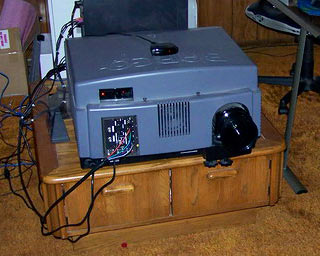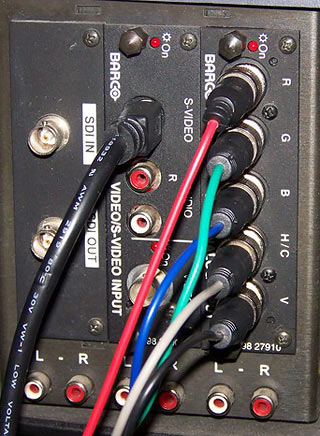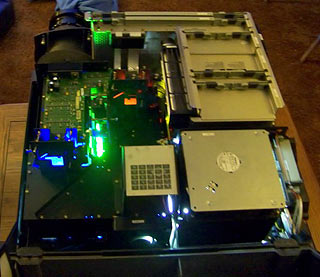
Dan's Data letters #193
Publication date: 14-Nov-2007.Last modified 03-Dec-2011.
The Great Energizer D Battery Conspiracy
I gather you are a bit keen on rechargeable batteries. I was scanning Reddit and I saw this article from NewsTarget.
Are "battery companies intentionally making rechargeable batteries with lower capacities in order to encourage the sale of more profitable throwaway alkaline batteries?"
How long have they been up to this?
Craig
Answer:
It's always been possible to buy lower capacity, cheaper D-size cells that're actually
just a D-sized shell around a standard "sub-C" cell. That's what the fearless NewsTarget
reporter has discovered, but any battery store could have told him what was going on
if he'd thought to ask.
These cheap D cells have been around for as long as I can remember, way back into the NiCd days. There's always been a sharp price and capacity break between these lightweight cells, which're for people who don't actually need all that much capacity but do need something that'll fit in a battery compartment that wants D cells, and the considerably more expensive but much higher capacity "solid" D cells.
Supermarket-brand rechargeables are never very good value, but NewsTarget's claim that a pair of these 2.5 amp-hour D cells cost $US25 is, indeed, pretty outrageous. Fortunately, a quick Froogle search shows that about ten bucks plus shipping is more like it.
That's still not fabulous value, but it's nothing to write angry editorials about.
Note that you can also now buy adapter casings that accept AA-sized cells and convert them into C or D cells. That's obviously not the way to go for maximum battery life, but if your D-powered radio or flashlight will run long enough from AAs, you might as well use 'em.
It is, of course, staggering that a site like newstarget.com could turn out to be so uncharacteristically ignorant about this one tiny subject. The NewsTarget home page contains many piercing insights about dietary supplements, "programming yourself for success" and "bio-energy", not to mention the startling revelation that aspartame, among other things, blocks the action of the Law of Attraction.
How could such spot-on truthseekers possibly have gone so wrong?
Sometimes you get a bargain, sometimes the bargain gets you
Is there some home-brew (or cheap) way to connect an SDI (Serial Digital Interface) display to my computer's DVI port?
I've seen some scalers and converters via Google, then the same ones on eBay that are extremely expensive (I'm operating under the "if you have to ask, you can't afford it" paradigm here). There doesn't appear to be much to them, but I get the feeling they contain black magic which my feeble DBA mind can't handle.
I ask because I was a bit foolish with my eBay account and find myself in quite the situation:
That would be a BarcoData 3300 DLC. I bought it because I thought it was one of those projectors that you carry to a small 12-man presentation that you have to give after stepping off an eight hour flight. I'm not sure this projector was actually even designed to move across the room.
Anyway, it's got three interface boards:
I'm using the S-Video because I need to upload a file to the projector using special software in order to use the RGBHV board. This configuration works, but the image quality is abysmal (even though I'm projecting it onto my 30yr old blinds, I'd expect it to be slightly sharper).
The specs for the projector indicate that it exceeds all known current and future HDTV standards, and I would dearly love a 113" HD viewing of Starship Troopers. Of course, that would probably scare the neighbors.
The only way I can see to get an HD picture out of it is via the SDI interface, which mystifies and scares me. I won't tell you how much I paid for on eBay, it'd probably make you mad.
I will tell you that the bulb is 700W, it has an operation lifespan of 750 hours, and costs $AU1400 through official channels (some places as low as $600).
My bulb is on its 395th hour.
I may also need to buy several thousand dollars worth of format converters...
Did I mention that it looks cool when it's running?
Nick
Answer:
I'd be pretty surprised if there was a cheap way to go from DVI to SDI. It's
apparently possible to hack SDI output into
certain DVD
players, but it's not a trivial venture.
Fortunately - or unfortunately, depending on how you look at it - it's a pretty pointless endeavour for you anyway, since your projector is, I regret to say, not as high-resolution as you think it is.
It's not impossible to find converter boxes with SDI output on (wait for it) eBay for cheap. But they're old models made before DVI was a gleam in the milkman's eye. Chaining a cheap DVI-to-component box and a cheap component-to-SDI box is of course a recipe for horribleness.
Whatever you have to do to get RGBHV component video working, though, is I think what you are going to have to do, if you don't just decide to shoot the thing like Elvis's car.
If you can get the projector to accept ordinary VGA output at 60Hz or something from a PC via a DB15-to-BNC cable and its RGBHV inputs, you'll be getting as good a picture as this projector (which apparently cost $US22500 in 2000!) can deliver.
This is because, Grasshopper, I think you'll find that what the specs actually say is not that the projector exceeds "all currently proposed HDTV, extended and improved television standards", but that it is compatible with them.
What that means is that you can, by hook or by crook, get this projector to accept every HD standard that was known about back in 2000 when it was new. That claim may or may not actually be true, but it hardly matters, because I'm pretty sure the projector's native resolution is only 800 by 600.
The specs page on barco.com just says it can accept resolutions up to 1280 by 1024, but that's pretty normal for old fancy projectors with 800 by 600 LCD panels.
Other sources concur on the 800 by 600 thing, and the fact that this is indeed not being a very portable projector - it weighs almost a hundred pounds. Just the same, though, I don't know why you're complaining about the bulk of the thing. It's only got one lens, after all!
An 800 by 600 projector can display DVD-resolution and Standard Definition TV images A-OK, but you won't get the full source resolution if you feed it anything bigger. It is not actually possible, by any means, to "get an HD picture out of it".
You can almost certainly get VGA out of your DVI video card, though - if it's got a DVI-I connector with the cross-shaped RGB pin block as per this picture, then you can plug a DVI-to-VGA pin adapter into it, and any normal VGA cable (or the abnormal HD15-to-BNC cable needed for the projector's inputs) into that.
Or you could just gin up a nice misleading eBay ad, and try to recoup some of your costs...
Nothing shoots a wire like a 528C
Can you recommend a camera to use for product shots? You mention a few in your photo tutorial, but they are no longer available.
I want to buy an inexpensive $AU200-300 camera.
If you're not sure of any specific ones, a general guide would be great - e.g. "avoid Sansui and Hitachi but Sony is OK".
I need to take photos of audio and video cables for my Web site.
Gregory
Answer:
The camera's almost irrelevant. Any little compact on a cheap plastic tripod will do.
Manual controls are a plus, but you could even scrape through with a full-auto camera.
All you really have to do is get the lighting right. That's not too hard, either - a couple of shop floods bounced off a white ceiling, or a similar equivalent wattage of compact fluorescents, will do nicely.
If you're photographing small-ish objects, I suggest you also buy or make a white translucent "tent" to put things in when you photograph them. With minimal attention to the exterior lamp placement, a tent will give your lighting that super-even pro studio look.
Collapsible tents with wire frames (they pop open like those car window shade things) are so cheap on eBay these days - under $AU30 including delivery for a 20 inch cube - that it's hardly worth the trouble of making your own.
There are tons of options under $AU300, but for value for money it's been hard to beat the Canon Powershot A5xx series for a few years now. The current cheap camera in that line is the Powershot A560, which is only $US130 or so. One with an Australian warranty shouldn't cost you more than $AU250.
If you want to use the camera for stuff other than product shots, the not-much-more-expensive A570 IS adds an image stabiliser. That's helpful because, like every other compact digicam since the world began, the Powershot can't use ISO sensitivities above about 200 without getting unacceptably noisy.
The stabiliser's completely irrelevant for product shots, though. If that's all you want, get the A560 and you'll save enough to buy a SUPER PROFESSIONAL LUXURY TRIPOD on eBay.
Regarding your "general guide" idea: Man, there's a concept - a Sansui digital camera.
Yes, if you ever see one of those, don't buy it!
(Sansui made highly regarded stereo equipment for years, but then they went broke and the name was bought by another company. So now they're like Bell and Howell, Agfa and Commodore - a "zombie brand" that gets slapped on cheap crap. There've been no cheap crappy Sansui cameras yet, though!)
Electrocution on the open road
I'm a pretty handy person, but mostly on mechanical stuff only. Electricity always confuses me. So here's a electricity question: Is it really safe to use one of those inverter things in a car? Those converting 12V DC to mains (here in US, 110V AC)?
I thought inverters would be dangerous because:
1: High voltage. 2: Easy ground (step out of the car). 3: Likelihood of wetness (rain).
Or am I unnecessarily paranoid?
If my concern is warranted, then aren't hybrid cars really really dangerous - surrounded by high voltage wiring?
I've read that emergency crews already require special procedures when dealing with hybrids in accidents - they cannot just cut through the roof, for example.
Peter
Answer:
How safe are inverters?
Fairly!
Portable inverters, in general, are not meant to be earthed. That's just as well, because it'd really suck if you had to drag an earth chain down the road behind your car or something.
What many modern inverters do offer, however, is full electrical isolation between the input and the output.
What this means is that, as long as there hasn't been some catastrophic failure of the inverter itself (which you could probably only bring about by pounding the inverter with a sledgehammer), there's no way a circuit can be formed between any of the inverter's AC terminals and any of its DC ones.
So if you hook the active wire coming out of an isolated inverter straight up to the positive lead going into it, or to the negative lead, or to the frame of the car (which should be the same as connecting it to the negative lead, in a conventional "negative ground" automobile), nothing should happen. Even if you accidentally connect the active wire to the car frame through your body, you should be safe. Only if you put yourself between active and neutral will you be in trouble, and that'll be the case whether you do it with an inverter socket or with an ordinary household outlet.
An isolated, ungrounded inverter may still have three-pin output sockets (here in Australia, it almost certainly will; in the USA it may not). I think the earth pins of the output sockets will just be connected to neutral, but I'm not sure; different countries have different opinions, and see this column for the surprising complexity of standards even for toasters.
The alternative to linking earth and neutral on the outlets would be just not connecting the outlet earth to anything.
With earth connected to neutral, a fault in an appliance that connects active to earth should just pop the inverter fuse or circuit breaker, which is a good outcome. If the earth pin on the inverter output socket is connected to nothing, you'd lose all semblance of earth protection in any connected appliances.
Modern stationary inverters (for solar power systems, for instance) are also isolated, but usually also earthed. In that situation, you leave the DC side ungrounded and ground the AC side (to a cold water pipe or stake hammered into the ground). That gives you the same sort of earth protection as you'd get from the ordinary mains.
Connecting the negative/neutral side of the DC input to another ground stake is not a good idea, because then an earth fault on the AC side will give you mains potential between the two ground stakes. If the stakes are relatively close together, this'll not just use a lot of power to heat up the ground, but also give enough of a voltage gradient across the ground that standing with your bare feet apart, between the stakes, could be enough to give you a dangerous shock.
This is also, by the way, why you shouldn't approach a downed high tension power line, crane that's driven into power lines, or other such pylon-to-ground situation. The contact point may be small, but it'll have a voltage gradient surrounding it that can give a dangerous potential difference over the distance of a normal stride.
(It might be safe to shuffle toward a downed high tension line with really small steps. But I wouldn't try it unless there was at least an eight-figure wager involved.)
And yes, the electrical systems of hybrid cars can be dangerous. But any old car can be dangerous - there are gallons and gallons of gasoline in there, for Pete's sake!
Hybrids do indeed add their own risks, but they're not as bad as you might think. For a start, all hybrids are meant to open relays that disconnect all of the wiring if a crash has been detected. Rescue personnel still have to take precautions just in case the relays have failed; one of those precautions may be to pull an easy-to-reach kill switch in the bodywork somewhere, like the ones in racing cars.
(After this page went up, a reader pointed me to this piece about hybrid emergency procedures. Apparently the kill switch for a hybrid is likely to be under the carpet in the boot/trunk. Note possible prank value.)
But the automatic systems are robust enough that they ought to work fine after most crashes.
Hybrids also don't run their high voltage DC wires next to each other, or have a negative-ground setup for their drive batteries. Over most of their length, the positive wires run through the car's chassis in one place and the negative wires run somewhere else.




